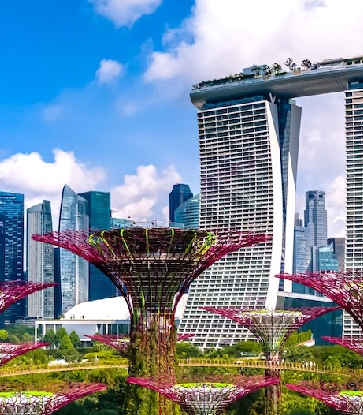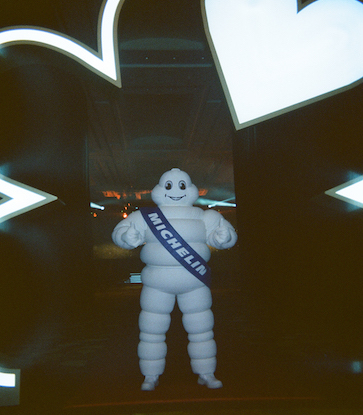Tribute To Mum In Restaurants Worldwide
If you walk into any one of Korean-American chef Akira Back’s restaurants all over the world from Dallas to Dubai, you’d be greeted by uber-modern, swanky interiors. But far from being contemporary and cold, look a little closer and you’d see the chef’s personal touch in the form of abstract art on the walls or ceilings and even plates — all designed by his mother specially for each location.
Back’s real name is Back Seung-Wook. Born in South Korea, his family moved to Aspen, Colorado, in the United States where he became a professional snowboarder for seven years during his teens. He confesses that he was never interested in cooking and really only started working for sushi master Kenichi Kanada in Aspen because he thought Kanada looked cool serving customers and wanted to be like him. “I had never cooked at home, I just ate whatever my mum gave me. I didn’t even know how to wash dishes because my mum did everything for me. So when I told my parents I wanted to be a chef, everybody laughed and then they got mad,” recalls the chef, chuckling.

It was a formula that worked, leading Back to open restaurants in more than a dozen cities in the next decade, including Dosa in Seoul which was awarded with a Michelin star in 2018. “Each of my restaurants all over the world has my personal touch and the first element is always my mum’s art.”
When Back was opening at the JW Marriott Singapore South Beach last year, the chef’s parents spent 10 days in Singapore with him. “She came into the restaurant and just stood there to look at the colours and get a feel of the space, and she went: ‘I’m feeling love, joy, peace, anger’. And she just starts drawing that feeling.” His mother’s energetic, colourful swirls of abstract art take pride of place not just in large frames along the dining hall, but also on the custom plates used to serve his signature dishes like the AB Tuna Pizza.

“The tuna pizza is my mum’s favourite dish, so I decided to put her art inside it. I want people to unveil a little more of the art underneath the pizza as they eat each slice and enjoy her art as they enjoy her favourite dish. While they’re eating it, I hope they think about their mothers too, that’s how I want to connect with my diners.”
Life Lessons From An Italian Mamma
Hailing from Lombardy in northern Italy, chef-owner Roberto Galetti of Michelin-starred Garibaldi in Singapore likes to say that the restaurant business was never in his blood because nobody in his family was a chef or worked in restaurants. Born to a poor family, his parents worked several jobs every day to make ends meet. “I remember my mamma coming back from work and looking so tired, but she would cook for the family and she would never lose an opportunity to teach me as well. She had so little time, but she spent it on me. And that became my love for food,” he says.


Galetti recalls fondly a time in 2010 when his parents flew to Singapore and his mother cooked alongside him for a special event at Garibaldi. They presented the dishes to guests together, his mother smiling proudly as the chef explained the dishes in English. “It was a special dinner and I really felt the connection with my mother. Seeing her so happy, I realised I was doing the right thing.”
A Mother’s Steadfast Support
The Peranakan culture of South-east Asia is as colourful as it is distinct. The matriarch of a Peranakan household is usually a formidable grandmother. While the men were breadwinners of the family, the women immersed themselves in the domestic arts like beading, embroidery and, of course, cooking.
Third-generation Peranakan chef Malcolm Lee of Michelin-starred Candlenut began his culinary journey by helping his mother and grandmother in the kitchen as a kid. His Peranakan upbringing — pounding spices with a mortar and pestle on the floor to the smells of rempah cooking and learning to taste the complexities of Nyonya cuisine — was essential to shaping his culinary worldview today.

The beginnings of the restaurant were not smooth-sailing, but he recalls that his mother stayed steadfastly by his side. “We were scraping by. My mum and I were sleeping in the restaurant every night just to maximise the amount of rest time that we had and save a bit of money.”

Over time, he developed his own style of modern Peranakan cooking that stays true to ethos of the cuisine with time-honoured recipes passed down from his mother, but that does not shy away from innovation and contemporary presentations. While he still serves the dishes on his a la carte menu family style with rice as the Peranakans do, he’s also created what he calls Ah-ma-kase tasting menus, a play on Japanese “omakase” and “ah ma”, a colloquial term to address your mother or grandmother. It was a nod to the way the matriarchs of the family approached Peranakan food by only selecting and cooking what was freshest in the market that day.
“I’m emotionally attached to smells and tastes of Peranakan cuisine. These flavours constantly remind me of the past — of family and roots,” he says.
RELATED: What do some of the world's top chefs have in common?






















